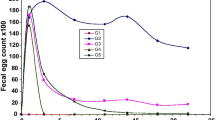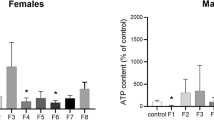Abstract
Haemonchus contortus infection is the major hurdle in growth and productivity in small ruminants especially in tropical countries. Indiscriminate and long term use of currently available chemotherapeutic agents lead to development of resistance in microorganisms and residual problems in population. Therefore, present study was undertaken to evaluate the anthelmintic efficacy of aqueous extract of Zanthoxylum armatum DC. seeds against adult H. contortus worms of small ruminants. Proximate analysis of seed powder shows high crude protein, Cu, Zn and Ca concentration. Phytochemical ingredients of extract revealed high total phenolic, flavonoids and tannin contents. In vitro experimental trial revealed complete mortality of H. contortus worms at the concentration of 100 mg/ml at the time exposure of 8 h. At 50 mg/ml concentration the mortality at 6 and 8 h were 45.45 ± 4.55 and 63.64 ± 4.54 %. Median lethal concentration (LC50) at 6 and 8 h were 59.90 and 28.92 mg/ml, respectively. Levamisole at concentration of 0.5 mg/ml caused 50 % mortality at 2 h post exposure and 100 % mortality at 4 h post exposure. The results confirm the cidal effect of the aqueous extract of Z. armatum DC. seeds on adult H. contortus worms.

Similar content being viewed by others
References
Ahmad A, Misra LN, Gupta MN (1993) Hydroxyalk-(4Z)-enoic acids and volatile components from the seeds of Zanthoxylum armatum. J Nat Prod 56:456–460
Akhtar MS, Iqbal Z, Khan MN, Lateef M (2000) Anthelmintic activity of medicinal plants with particular reference to their use in animals in Indo-Pakistan subcontinent. Small Rumin Res 38:99–107
Alvarez-Sanchez MA, Perez-Garcia J, Cruz-Rojo MA, Rojo-Vazquez FA (2006) Anthelmintic resistance in trichostrongylid nematodes of sheep farms in Northwest Spain. Vet Parasitol 99:78–83
AOAC (1995) Official Methods of Analysis 16th edn. Association of Official Analytical Chemists, Washington, DC, USA 4(1–4):17
Atoui K, Mansouri A, Bosku G, Kefalas P (2005) Tea and herbal infusions: their antioxidant activity and phenolic profile. Food Chem 89:27–36
Burke JM, Miller JE, Brauer DK (2005) The effectiveness of copper oxide wire particles as an anthelmintic in pregnant ewes and safety to offspring. Vet Parasitol 131:291–297
Chan K (2003) Some aspects of toxic contaminants in herbal medicines. Chemosphere 52:1361–1371
Chartier C, Soubirac F, Pors I, Silvestre A, Hubert J, Couquet C, Cabaret J (2001) Prevalence of anthelmintic resistance in gastrointestinal nematodes of dairy goats under extensive management conditions in southwestern France. J Helminthol 75:325–330
Domke AV, Chartier C, Gjerde B, Hoglund J, Leine N, Vatn S, Stuen S (2012) Prevalence of anthelmintic resistance in gastrointestinal nematodes of sheep and goats in Norway. Vet Parasitol 111:185–193
Easwaran C, Harikrishnan TJ, Raman M (2009) Multiple anthelmintic resistance in gastrointestinal nematodes of sheep in southern India. Vet Arhiv 79:611–620
Hounzangbe-Adote MS, Paolini V, Fouraste I, Moutairou K, Hoste H (2005) In vitro effects of four tropical plants on three stages of the parasitic nematode, Haemonchus contortus. Res Vet Sci 78:155–160
Khajuria JK (2010) Studies on epidemiology and resistance against benzimidazoles in gastrointestinal nematodes of small ruminants. PhD thesis, SKUAST-Jammu
Kolmer JA, Spandling EH, Robinson HW (1951) Applied laboratory Techniques. Appleton Centuary Croft, New York, pp 1090–1091
Makkar HPS, Bluemmel M, Borowy NK, Becker K (1993) Gravimetric determination of tannins and their correlations with chemical and protein precipitation methods. J Sci Food Agric 61:161–165
Martinez Ortis-de Montellano C, Vargas-Magana JJ, Aguilar-Caballero AJ, Sandoval-Castro CA, Cob-Galera L, May-Martinez M, Miranda-Soberanis R, Hoste H, Camara Sarmiento R, Torres-Acosta JFJ (2007) Combining the effects of supplementary feeding and copper oxide needles in browsing goats. Vet Parasitol 146:66–76
Mehta MB, Kharya MD, Srivastava R, Varma KC (1981) Antimicrobial and anthelmintic activities of the essential oil of Zanthoxylum alatum Roxb. Indian Perfum 25:1–3
Sager H, Hosking B, Bapst B, Stein P, Vanhoff K, Kaminsky R (2009) Efficacy of the amino-acetonitrile derivative, monepantel, against experimental and natural adult stage gastrointestinal nematode infections in sheep. Vet Parasitol 159:49–54
Sarver J, Kumar S, Khan M, Ara M, Anand VK (2009) Diversity, distribution and utilization pattern of economically important woody plants associated with agro-forestry in district Rajouri, J & K (Northwest Himalaya). Ethnobot Leafl 13:801–809
Savitree M, Isara P, Nittaya SL, Worapan S (2004) Radical Scavenging Activity and Total Phenolic Content of Medicinal plants Used in Primary Health Care. J Pharmacol Sci 9:32–35
Siddiqui N, Garg SC (1990) In vitro anthelmintic activity of some essential oils. Pak J Sci Ind Res 33:536–537
Singh TP, Singh OM (2011) Phytochemical and Pharmacological profile of Zanthoxylum armatum DC—An overview. Indian J Nat Prod Resour 2:275–285
Singh R, Verma PK, Singh G (2012) Total phenolic, flavonoids and tannin contents in different extracts of Artemisia absinthium. J Intercult Ethnopharmacol 2:101–104
Tariq KA, Chishti MZ, Ahmad F, Shawl AS (2009) Anthelmintic activity of extracts of Artemisia absinthium against ovine nematodes. Vet Parasitol 160:83–88
The Wealth of India (1976) A dictionary of Indian raw materials and industrial products. Publication and Information Directorate, CSIR New Delhi
Tiwary M, Naika SN, Tewary DK, Mittal PK, Yadav S (2007) Chemical composition and larvicidal activities of the essential oil of Zanthoxylum armatum DC (Rutaceae) against three mosquito vector. J Vector Borne Dis 44:198–204
Velioglu YS, Mazza G, Gao L, Oomah BD (1998) Antioxidant activity and total phenolics in selected fruits, vegetables, and grain products. Food Chem 46:4113–4117
Verma N, Khosa RL (2010) Hepatoprotective activity of leaves of Zanthoxylum armatum DC in CCl4 induced hepatotoxicity in rats. Indian J Biochem Biophys 47:124–127
Waruiru RM, Mutunu MN, Otieno RO (2004) Efficacy of copper needles for the control of gastrointestinal nematodes in goats. In: Proceeding of the 13th Annual Meeting of ENRECA Livestock Helminth Research Project, pp 35
Zhishen J, Mengcheng T, Jianming W (1999) The determination of flavonoid contents in mulberry and their scavenging effects on superoxide radicals. Food Chem 64:555–559
Acknowledgments
Authors thank to the Dean, Faculty of Veterinary Sciences and Animal Husbandry, SKUAST-J, R S Pura, Jammu for providing necessary research facilities.
Author information
Authors and Affiliations
Corresponding author
Rights and permissions
About this article
Cite this article
Singh, G., Singh, R., Verma, P.K. et al. Anthelmintic efficacy of aqueous extract of Zanthoxylum armatum DC. seeds against Haemonchus contortus of small ruminants. J Parasit Dis 40, 528–532 (2016). https://doi.org/10.1007/s12639-014-0540-5
Received:
Accepted:
Published:
Issue Date:
DOI: https://doi.org/10.1007/s12639-014-0540-5




